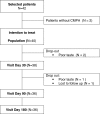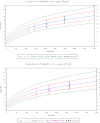Safety and tolerance of a new extensively hydrolyzed rice protein-based formula in the management of infants with cow's milk protein allergy
- PMID: 24723091
- PMCID: PMC4134482
- DOI: 10.1007/s00431-014-2308-4
Safety and tolerance of a new extensively hydrolyzed rice protein-based formula in the management of infants with cow's milk protein allergy
Abstract
Guidelines recommend the use of extensively hydrolyzed cow's milk protein-based formulas (eHF) in the treatment of infants with cow's milk protein allergy (CMPA). Extensively hydrolyzed rice protein infant formula (eRHF) has recently become available and could offer a valid alternative. A prospective trial was performed to evaluate the hypo-allergenicity and safety of a new eRHF in infants with a confirmed CMPA. Patients were fed the study formula for 6 months. Clinical tolerance of the eRHF was evaluated with a symptom-based score (SBS) and growth (weight and length) was monitored. Forty infants (mean age, 3.4 months; range, 1-6 months) with CMPA confirmed by a food challenge were enrolled. All infants tolerated the eRHF and the SBS significantly decreased as of the first month of intervention. Moreover, the eRHF allowed a catch-up to normal weight gain as of the first month as well as a normalization of the weight-for-age, weight-for length, and BMI z-scores within the 6-month study period.
Conclusion: In accordance with current guidelines, this eRHF was tolerated by more than 90 % of children with proven CMPA with a 95 % confidence interval. This eRHF is an adequate and safe alternative to cow milk-based eHF.
Figures
References
-
- Agostoni C, Axelsson I, Goulet O, ESPGHAN committee of Nutrition Soy protein infant formulae and follow on formulae a commentary by the ESPGHAN. J Pediatr Gastroenterol Nutr. 2006;42(4):352–361. doi: 10.1097/01.mpg.0000189358.38427.cd. - DOI - PubMed
-
- Agostoni C, Fiocchi A, Riva E, Terracciano L, Sarratud T, Martelli A, Lodi F, D’Auria E, Zuccotti G, Giovannini M. Growth of infants with IgE-mediated cow’s milk allergy fed different formulas in the complementary feeding period. Pediatr Allergy Immunol. 2007;18(7):599–606. doi: 10.1111/j.1399-3038.2007.00566.x. - DOI - PubMed
-
- American Academy of Pediatrics Committee on Nutrition. Hypoallergenic infant formula. Pediatrics. 2000;106(2Pt1):346–349. - PubMed
-
- Commission Directive 98/83/EC on the quality of water intended for human consumption
Publication types
MeSH terms
Substances
LinkOut - more resources
Full Text Sources
Other Literature Sources
Medical



